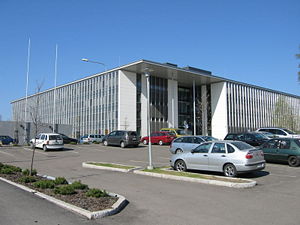Finnish Meteorological Institute
The Finnish Meteorological Institute (Finnish:Ilmatieteen laitos) or FMI is the government agency responsible for gathering and reporting weather data and forecasts in Finland. It is a part of the Ministry of Transport and Communications but it operates semi-autonomously.
FMI is a research and service organization with expertise covering a wide range of atmospheric science activities other than gathering and reporting weather data and forecasts.
Organization
FMI is governed by an advisory board within the Ministry of Transport and Communications and a Director General who is the operational executive of the FMI.
The FMI has three major divisions:
- Weather and Safety division that includes these functions:
- Weather and safety centre: Provides the public forecasts and warnings associated with safety, services for the officials, and aviation and military weather services.
- Commercial services: Provides consulting, measurement and training services.
- Observation services: Manages the weather observation stations.
- Research and Development division that includes these areas of study:
- Climate change
- Air quality
- Meteorology
- Arctic research
- Earth observation
- Consulting services
- Administrative services
Location and staff
In 2005, FMI moved into a new building (known as the Dynamicum) located within the University of Helsinki's Kumpula campus in Helsinki. FMI shares the building with the Finnish Institute of Maritime Research (FIMR).
The number of full-time staff of the Finnish Meteorological Institute is about 540. Permanent staff members account for about 2/3 of the Institute's personnel and those with contractual posts account for the remainder. The Institute operates in on a round-the-clock basis and about 30 percent of the full-time staff work in shifts.
54 percent of the staff have university degrees and 15 percent have a licentiate or PhD degree.
Air quality activities
The Finnish Meteorological Institute has investigated air quality processes and air pollution prevention techniques since the early 1970s. Their staff members have comprehensive competence within the areas of meteorology, physics, chemistry, biology and engineering. Integrated work is done in cooperation with many other European research institutes and universities.
The air quality activities conducted by the Institute include:
- Research, testing and development of air quality measuring methods and equipment.
- Development of air pollutant emission inventories.
- Development of air pollution dispersion models[1][2][3]
- Performing chemical analyses of air quality.
- Study and development of air pollution prevention techniques.
The suite of local scale (0 - 30 km) dispersion models available at the FMI includes:
- An urban area, multiple-source dispersion model.
- Vehicular pollution line-source dispersion models.
- Dispersion models for hazardous materials.
- Dispersion models for odorous compounds.
Dispersion models for larger scales (30 to 3000 km) are also available.
References
- ↑ Turner, D.B. (1994). Workbook of atmospheric dispersion estimates: an introduction to dispersion modeling, 2nd Edition. CRC Press. ISBN 1-56670-023-X. www.crcpress.com
- ↑ Beychok, Milton R. (2005). Fundamentals Of Stack Gas Dispersion, 4th Edition. author-published. ISBN 0-9644588-0-2.
- ↑ Schnelle, Jr., Karl B. and Dey, Partha R. (2000). Atmospheric Dispersion Modeling Compliance Guide. McGraw-Hill. ISBN 0-07-058059-6.
